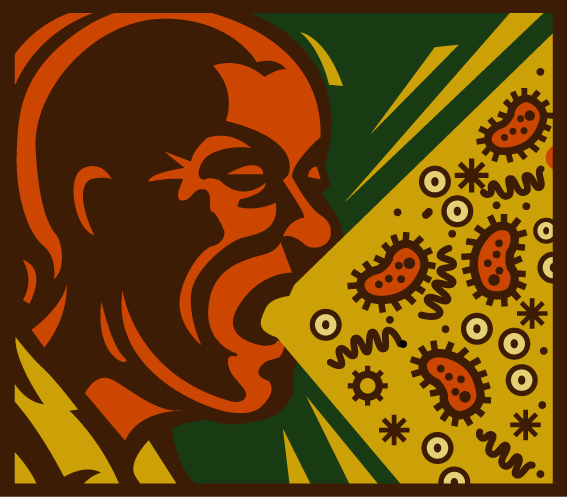 Beginning in January
2003, key military personnel and emergency healthcare workers will get the
first doses from the U.S. smallpox vaccine stockpile, according to plans
President Bush will announce Friday. In 2004, all Americans will be offered
smallpox vaccinations on a voluntary basis. Beginning in January
2003, key military personnel and emergency healthcare workers will get the
first doses from the U.S. smallpox vaccine stockpile, according to plans
President Bush will announce Friday. In 2004, all Americans will be offered
smallpox vaccinations on a voluntary basis.
"I think it ought to be a voluntary plan," President Bush told
ABC. "What's going to be very important for us is to make sure that
there's ample information for people to make a wise decision."
The plan has three phases. First, a half million members of the armed
forces and another half million emergency-room workers and those on smallpox
response teams will get vaccinated. Next would come some 10 million other
emergency response workers: police, firefighters, and ambulance crews. The
final phase - offering the vaccine to the public - will occur as soon as
the U.S. Food and Drug Administration (FDA) can license the vaccine.
In case of a smallpox bioterrorist attack, the vaccine would be made widely
available without licensing.
The U.S. smallpox vaccine stockpile now holds smallpox vaccine to cover
every one of America's 288.6 million residents. Because old vaccine stocks
can be diluted to stretch them out, there are about 75 million doses of
the 1970s-era Dryvax vaccine and some 300 million doses of the 1950s-era
Wetvax vaccine. Another 209 million doses of a modern smallpox vaccine will
be stockpiled soon.
Why not just offer everyone the vaccine right away? There are two issues.
One is that the FDA has not had time to license every lot of the vaccine
stockpile. The government could offer unlicensed vaccine under investigational
new drug rules. But these rules come wrapped in red tape. Everyone who wanted
the vaccine would have to file a reason why they need
it, creating mountains of paperwork.
The other issue is safety. In the U.S. in 1968, for example, some 14 million
people received the vaccine. That year there were 572 adverse reactions
resulting in nine deaths. In those days, adverse reactions were treated
with serum from people who recovered from infection with the
vaccine virus. This vaccinia immune globulin, or VIG, now is in very short
supply.
If everyone in the U.S. were vaccinated, there would be some 180 deaths,
estimates William J Bicknell, MD, MPH, founder of the Boston University
School of Public Health and former commissioner of the Massachusetts Department
of Public Health. About 15 of every million people vaccinated would have
a life-threatening reaction. Especially troubling is the
estimated 100,000 U.S. residents who are infected with HIV but don't know
it, because immunocompromised people are particularly at risk for an adverse
reaction from the vaccine.
"The decision people have to make is, 'Do I think after September 11
that there is a big enough risk of a bioterrorist having smallpox and getting
it to this country that I want to protect myself and my family?'" Dr.
Bicknell told Medscape. "If the answer is yes, you lobby for vaccine
access and get immunized, but you make sure you are not immunosuppressed
or have HIV, that you are not an infant, that you are not a person with
a skin rash. Then -
if a supply of vaccinia immune globulin is available - you decide 'OK, I'll
get the vaccination. I'll have a sore arm, maybe a swollen arm, but I am
quite willing to accept a one-in-a-million or less chance of death.'...It
is the risk people face every day they get in the car and go to work."
At risk are people with eczema, people with immune diseases such as HIV
or those who take immunity-suppressing drugs, infants, and pregnant women.
Accidental infection can also happen to nonvaccinated people who are around
a vaccinated person and get vaccinia virus in their eyes or mouths. Those
at risk can also develop systemic vaccinia, which causes disfiguring generalized
pock marks that will scar permanently. The vaccine can also
kill. In the past, most deaths have been among infants who caught the virus
from recently vaccinated brothers or sisters.
These risks mean that an estimated 50 million Americans should not get the
smallpox vaccine. This number does not include members of their households.
They, too, should not be vaccinated because they might infect the at-risk
person with the live vaccine virus.
The new, modern vaccine is expected to be safer than the old vaccines, but
its full safety still needs testing. And whether it will protect against
smallpox exposure can't ethically be tested.
However, people who receive the vaccine develop immune responses that appear
to be protective.
At least one hurdle to widespread smallpox vaccination is gone. In November,
President Bush signed into law a bill that forbids the families of people
killed by the vaccine from suing doctors or other healthcare workers.
Nearly all states recently filed smallpox vaccination plans with the federal
government. These plans vary widely. Georgia would vaccinate only a few
hundred healthcare workers, while California would vaccinate many thousands.
All of these vaccinations would be strictly voluntary.
A recent poll by the Robert Wood Johnson Foundation found that two out of
three Americans say they would be willing to take the smallpox vaccine.
Reviewed by Gary D. Vogin, MD
Back To Top |
|
"These risks mean that an estimated
50 million Americans should not get the smallpox vaccine. This number does
not include members of their households. They, too, should not be vaccinated
because they might infect the at-risk person with the live vaccine virus." |